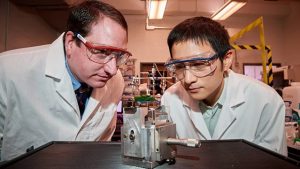
Researchers from the University of Connecticut’s Institute of Materials Science have discovered a surprising new way to improve the performance of semiconductor material. The atomically thin semiconductor material can have its properties enhanced by stretching it. This could prove an enormous benefit to all sorts of applications, from flexible electronics to optical sensors.
According to researchers, introducing strain to a material can have some startling effects. When strain was applied to a six-atom thick bilayer of tungsten diselenide, it displayed a 100-times increase in photoluminescence. Before straining the material, it had never displayed any photo-luminescent properties.
This research is the first time scientists have successfully proved that it’s possible to mechanically manipulate atomically thin materials in order to improve their performance. The discovery could significantly help with efforts to develop faster computer processors and more powerful sensors.
While the results are inarguably significant, so is the process used to achieve them. By proving mechanical manipulation can be effective, scientists now have a new methodology that will allow them to measure the impact of strain on other ultra-thin materials.
“Experiments involving strain are often criticized since the strain experienced by these atomically thin materials is difficult to determine and often speculated as being incorrect. Our study provides a new methodology for conducting strain-dependent measurements of ultra-thin materials, and this is important because strain is predicted to offer orders of magnitude changes in the properties of these materials across many different scientific fields.”
While graphene and silicon have long been used as semiconductors, they are not ideal choices. Their limitations have made advances in this field problematic, and scientists have long been on the search for superior semiconductor materials. The secret could lie in other two-dimensional, atomically thin materials, as their structure makes them especially good for bending and stretching.
Scientists measured the influence of strain on a single crystalline bilayer of tungsten diselenide. They did this by encapsulating it in a fine layer of acrylic glass. Next, the material was heated in an argon gas chamber; this was a key aspect of the experiment, as exposure to air would end up destroying the sample. The thermal process helped to strengthen the material’s adhesion to a polymer substrate. This allowed for a virtually perfect transfer of the applied strain — a feat that scientists had found nearly impossible in previous experiments. Finally, the scientists customized a bending device so they could carefully increase the strain on the materials.
The results of the experiment (and the experiment itself) have essentially changed the game for semiconductors. The research team will continue their research on tension and how it could enhance the traits of atomically thin materials for a variety of applications — particularly faster and more powerful semiconductors.
